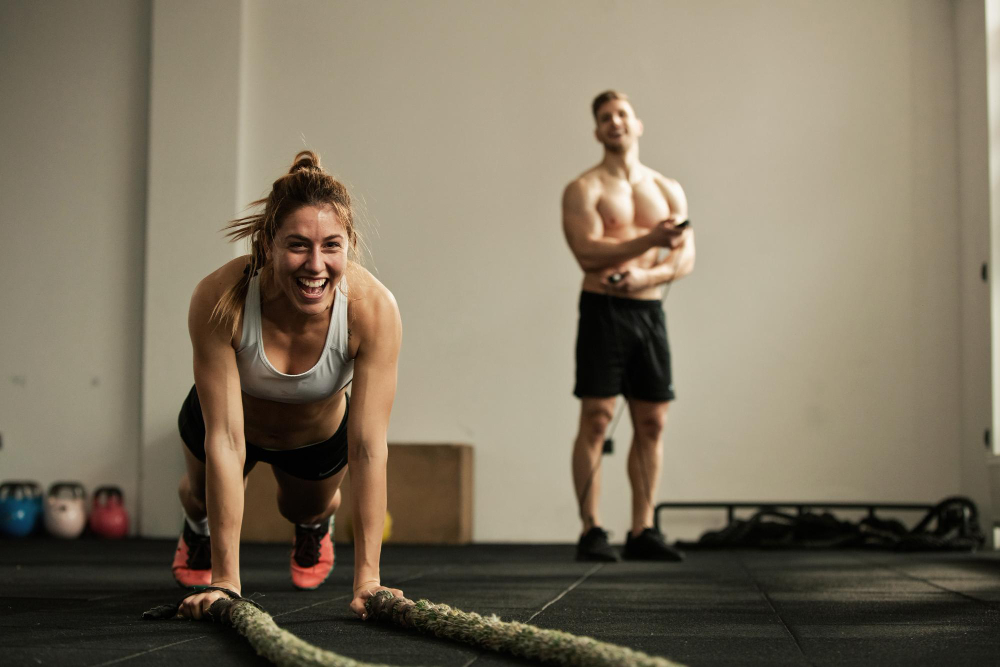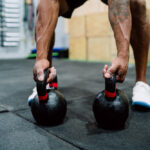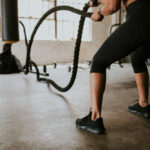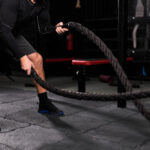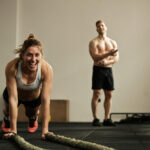If you’re planning to use battle ropes in your workout routine, you already know they deliver a full-body burn. While it feels like everything is on fire, not all muscles are working the same way. That’s why understanding the muscles worked with battle ropes can help you decide when and how to slot them into your training.
Upper Body Muscles Worked
When people see someone hammering away on battle ropes, the first thought is usually: “That must be an arm workout.” And sure, your arms are on fire within seconds, but ropes go way beyond that.
- Shoulders (Delts): Every wave, slam, or spiral demands shoulder power. Your delts keep the ropes moving and stabilize your upper body so you don’t collapse halfway through.
- Biceps & Triceps: Your arms are constantly contracting to whip the ropes up and down. The push-pull balance of triceps extending and biceps flexing makes them work overtime.
- Forearms & Grip: This is the sneaky part. Holding thick ropes for even 30 seconds torches your forearms. If your grip fails before your lungs do, welcome to the club. You just discovered a new weak spot.
- Upper Back & Traps: Especially during double slams or rope pulls, your traps and rhomboids jump in to keep you upright and explosive.
Core Muscles Worked
If there’s one area battle ropes secretly destroy, it’s your core. You might not notice it at first, but after a few sets, your abs will be screaming louder than your arms.
- Abs & Obliques: Every wave forces your core to brace like you’re taking a punch. Side-to-side rope variations crank up the rotation and give your obliques a serious workout.
- Lower Back & Spinal Stabilizers: Staying upright while slamming ropes isn’t easy. Your erector spinae and deep stabilizers are constantly firing to keep your spine safe and your posture solid.
- Hip Flexors: Not a main player, but they help with balance. Especially if you’re moving or adding lunges into your rope routine.
Lower Body Muscles Worked
Most people don’t think “leg day” when they see battle ropes, but your lower body is far from off the hook.
- Glutes & Quads: If you’re doing squats, jump slams, or drop into an athletic stance while whipping the ropes, your glutes and quads are firing non-stop. They keep you grounded and explosive.
- Hamstrings: Anytime you hinge at the hips, like during rope pulls or low waves, your hamstrings step in to stabilize and power the movement.
- Calves: Even when you’re not moving your feet, your calves are lit up just holding you steady.
Conditioning & Secondary Benefits
Along with all these muscles worked, battle ropes can also bring other perks.
- Cardiovascular Hit: The ropes demand constant, explosive effort. Your lungs and heart are working overtime, which makes them perfect for HIIT-style training.
- Muscular Endurance: Holding onto thick ropes while churning out wave after wave builds insane stamina in your shoulders, arms, and grip.
- Explosiveness & Coordination: Ropes require rhythm. Your nervous system learns how to sync power, speed, and timing, which carries over into sports and lifting.
FAQ
Are battle ropes just an arm workout?
No. While your arms will feel it first, battle ropes work your shoulders, back, core, and even legs.
Do battle ropes build muscle or just burn calories?
Mostly endurance and conditioning. They won’t replace heavy lifting for pure muscle growth, but they’ll build strength, endurance, grip power, and explosive capacity while torching calories.
Can beginners use battle ropes?
Absolutely. Just start light. Shorter intervals, slower waves, and focus on form. Ropes look intimidating, but they scale easily to any fitness level.
Do battle ropes work abs?
Yes. Every movement requires bracing your core. Side-to-side waves and rotational moves especially light up the abs and obliques.
Key Takeaways
Battle ropes are a powerful exercise that you should consider including in your routine.
- Shoulders, arms, forearms, and upper back get smoked every set.
- Abs, obliques, and stabilizers fire non-stop to keep you braced and balanced.
- Glutes, quads, hamstrings, and calves all contribute, especially with dynamic moves.
- Ropes push your heart, lungs, and muscular endurance to the limit.
- Perfect for HIIT, sports performance, or simply spicing up your workouts.

